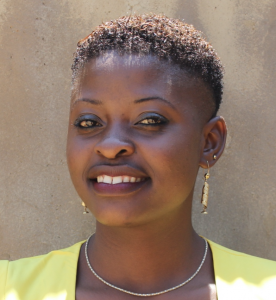The 157 staff and students of Eshiandukusi Secondary School struggle to access sufficient water daily. Students are expected to fetch water, but they sacrifice crucial learning time due to the overcrowding at their primary water source, a community dug-well with a pump.
Students arrive at school early to wait in long lines to collect water for the day in jerricans they bring from home because the school has no water storage. This often makes them late to class and makes it hard for them to learn.

Field Officer Jemmimah Khasoha shared, "[During the] morning hours, the students and community members all come to collect water. The chaos and the struggle for water are not something good. Students come out with wet uniforms, and this makes them not concentrate in class."

"Our classroom is dusty on the floor. This means that every morning and [at] lunch hours we need to sprinkle water. This is very tiresome because it requires us to go to the primary section [to collect more water], and there is a lot of congestion," said 16-year-old Phaustine M.

"Lack of water on the school grounds has really made life tough, and one does not wish to come to school the following day," Phaustine, shown below at the front of the line, continued.

Extreme congestion isn't the only challenge Eshiandukusi Secondary School faces with its waterpoint.
"The other challenge of using this water comes during the dry season. This is when the students are released to get water from the nearby source. This makes many to be absent, and it affects the performance," continued Field Officer Jemmimah.
During the dry season, the dug well goes dry. This forces the school to send students out to look for water elsewhere or pay to have water brought into the school, which is very expensive.
Teacher Peter Ndili, seen below teaching, shared how the water crisis affects his students, "Personally, I have been affected in terms of finishing the syllabus and having [a] rough time in [the] dry season. We do not have a storage container for drinking water. Thus, we use our own bottles or send students, which is very risky."

Installing a borehole well will ensure that Eshiandukusi Secondary School will have year-round access to water on their campus, as drilled wells are much deeper.
Phaustine and other students can focus on their education with quick access to water, eliminating wasted time. Teachers can complete their curriculum without sacrificing learning time.
Water at schools is unique, which is why we need unique solutions.
The Proposed Solution, Determined Together...
At The Water Project, everyone has a part in conversations and solutions. We operate in transparency, believing it benefits everyone. We expect reliability from one another as well as our water solutions. Everyone involved makes this possible through hard work and dedication.
In a joint discovery process, community members determine their most advantageous water solution alongside our technical experts. Read more specifics about this solution on the What We're Building tab of this project page. Then, community members lend their support by collecting needed construction materials (sometimes for months ahead of time!), providing labor alongside our artisans, sheltering and feeding the builders, and supplying additional resources.
Water Access for Everyone
This water project is one piece in a large puzzle. In Kenya, Sierra Leone, and Uganda, we're working toward complete coverage of reliable, maintained water sources that guarantee public access now and in the future within a 30-minute round trip for each community, household, school, and health center. One day, we hope to report that this has been achieved!
Training on Health, Hygiene & More
With the community's input, we've identified topics where training will increase positive health outcomes at personal, household, and community levels. We'll coordinate with them to find the best training date. Some examples of what we train communities on are:
- Improved hygiene, health, and sanitation habits
- Safe water handling, storage & treatment
- Disease prevention and proper handwashing
- Income-generation
- Community leadership, governance, & election of a water committee
- Operation and maintenance of the water point
Handwashing Stations
Alongside each water source, we also provide two new gravity-fed handwashing stations that will allow everyone at the school to wash their hands without running water. Handwashing is so important to help prevent future water-related illnesses in the school community.
The student health club will maintain the stations, fill them with water, and supply them with soap (which we will teach the school community how to make during the training!).
VIP Latrines
In addition, we will construct two triple-door Ventilated Improved Pit (VIP) latrine blocks designed to prevent fecal disease transmission. Each latrine will have a cement floor, which is easy to use and clean regularly. Three doors will serve the girls, and three doors will serve the boys.

 Borehole Well and Hand Pump
Borehole Well and Hand Pump
 Rehabilitation Project
Rehabilitation Project

































